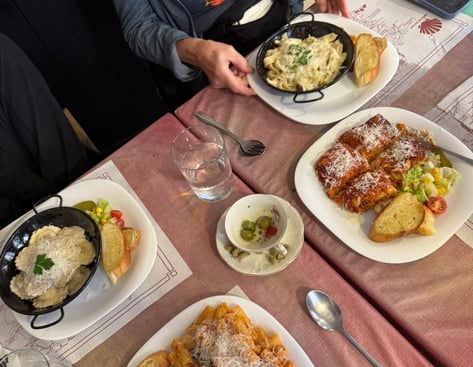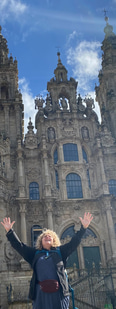The Camino Table: Sharing Meals and Stories
5/8/20242 min read


The Food on the Camino
Savoring the Camino: A Taste of the Journey
The Camino de Santiago is a journey that feeds the soul—and the body. As you walk through the varied landscapes of Spain, one of the unexpected joys is discovering the rich culinary traditions along the way. Food on the Camino is not just about sustenance; it’s about connection, culture, and savoring simple pleasures. Here’s a guide to what you can expect to eat on your journey and how to make the most of the experience.
Breakfast on the Camino
Mornings on the Camino often start early, and breakfast (or desayuno) is typically light. In most towns and albergues, you’ll find:
Toast or Pastries: Simple but satisfying options like tostada (toasted bread with jam or tomato) or croissants.
Coffee: Spaniards take their coffee seriously, and you’ll quickly become familiar with a comforting cup of cafe con leche (coffee with milk).
Fresh Orange Juice: Look out for freshly squeezed zumo de naranja to give you an energizing start to the day.
Pro Tip: If you need something heartier, stop by a local bakery for a sandwich (bocadillo) to take on the road.
Snacks Along the Way
Walking the Camino burns calories, and you’ll need to refuel throughout the day. Popular snacks include:
Fruit: Apples, bananas, and oranges are readily available at markets and grocery stores.
Nuts and Seeds: A lightweight and nutritious option to keep your energy up.
Tortilla Española: This hearty Spanish potato omelet is a must-try and makes for a great midday pick-me-up.
Many small villages have cafes or vending machines offering quick bites, so you’re never far from a snack.
Lunch and Dinner
When it comes to main meals, the Camino offers a wonderful array of traditional Spanish dishes. Here are some highlights:
Pilgrim’s Menu: Most towns along the Camino offer a Menú del Peregrino, a three-course meal specifically designed for pilgrims. For around €10-15, you’ll enjoy:
A starter like soup, salad, or pasta.
A main course such as grilled chicken, fish, or lomo (pork loin).
Dessert, often flan or yogurt.
Bread and wine are usually included.
Regional Specialties: As you cross different regions of Spain, take the opportunity to savor local dishes. For example:
In Galicia: Try pulpo a la gallega (Galician-style octopus) and empanadas filled with meat or fish.
In Castilla y León: Enjoy hearty stews like cocido maragato.
Connecting Over Meals
Food on the Camino is as much about the company as the cuisine. Sharing meals with fellow pilgrims creates a sense of camaraderie and community. Many albergues host communal dinners, where you can bond over simple, home-cooked meals and stories of the day’s walk.
Budget-Friendly Tips
Visit local markets for fresh produce and prepare your own meals in albergue kitchens.
Grocery stores often have ready-to-eat items like cured meats, cheeses, and bread for an affordable picnic.
Tap water is safe to drink in most places, so carry a refillable bottle to save on beverages.
Savor the Experience
Walking the Camino teaches you to appreciate life’s simple pleasures, and food is no exception. Whether it’s a leisurely meal at a rustic tavern or a quick snack by the roadside, take time to savor the flavors and the moment. Every bite is a reminder that nourishment comes in many forms, and on the Camino, each meal is part of the journey.
Buen provecho and Buen Camino
